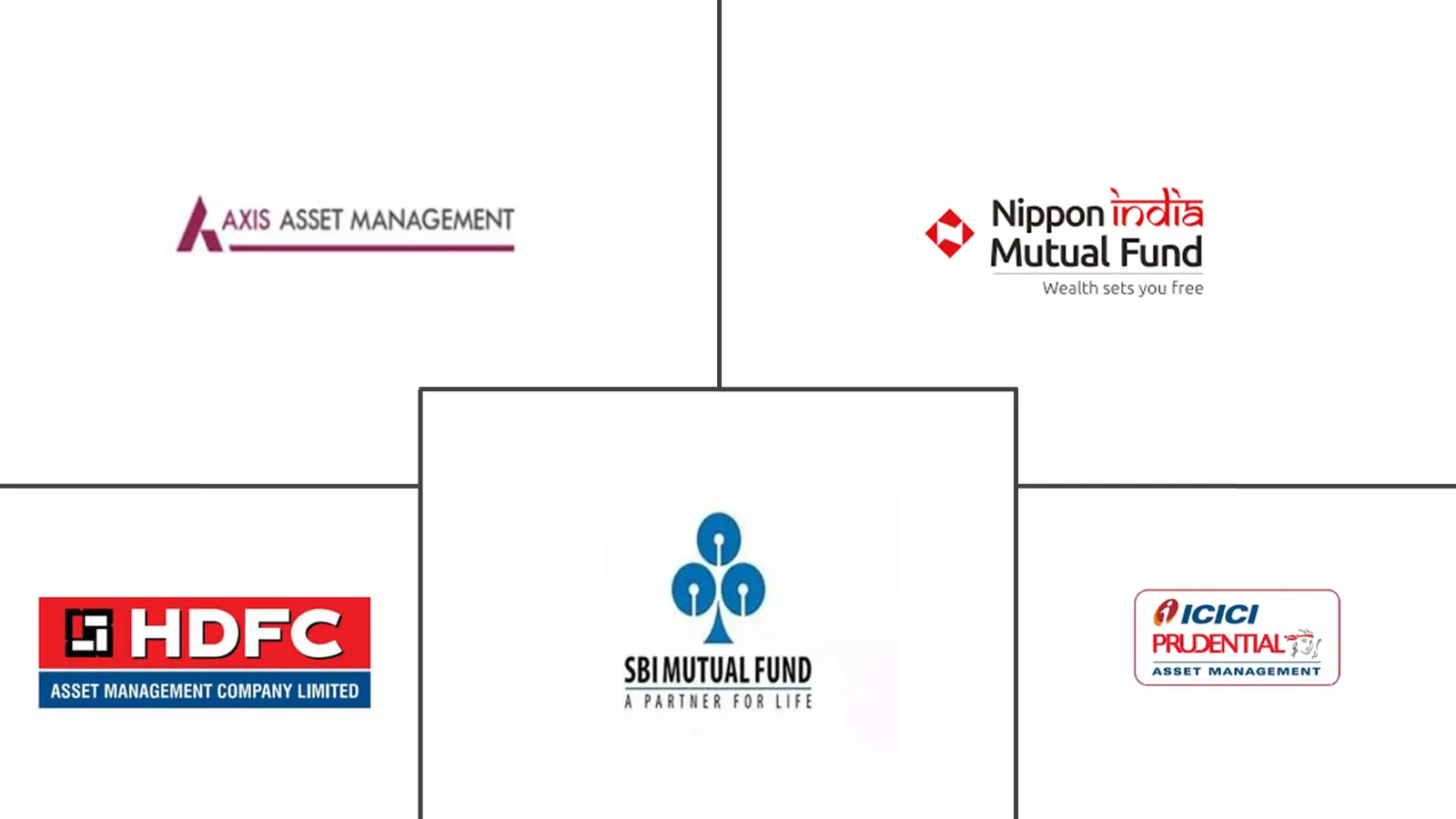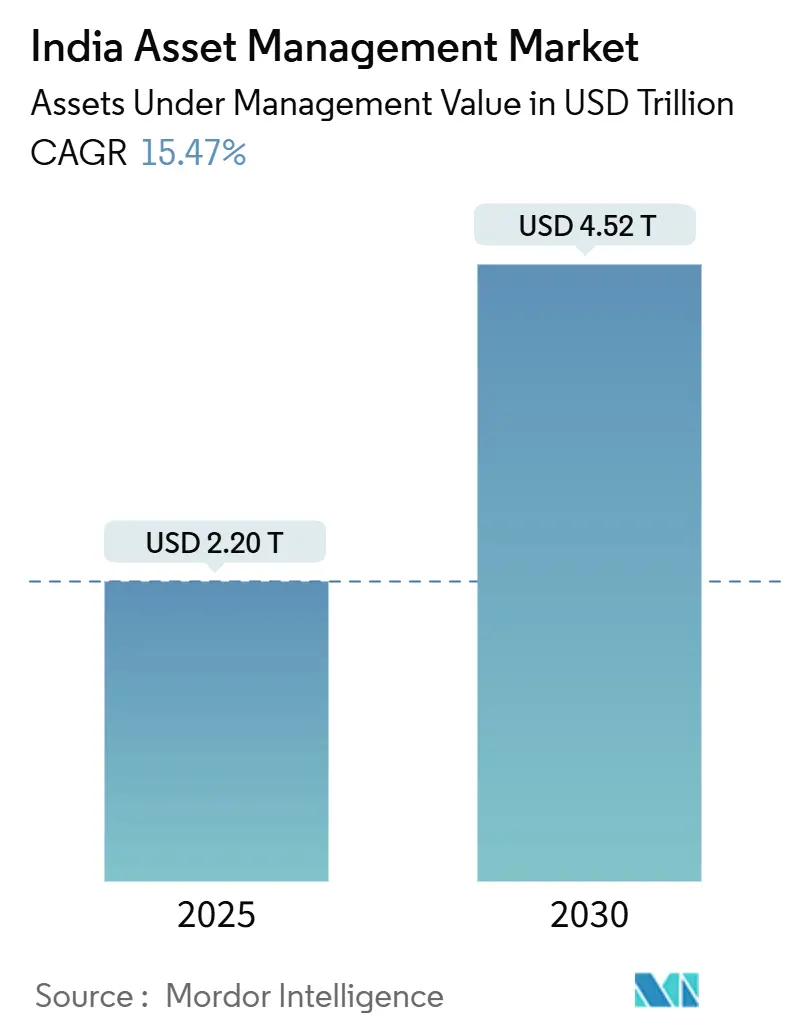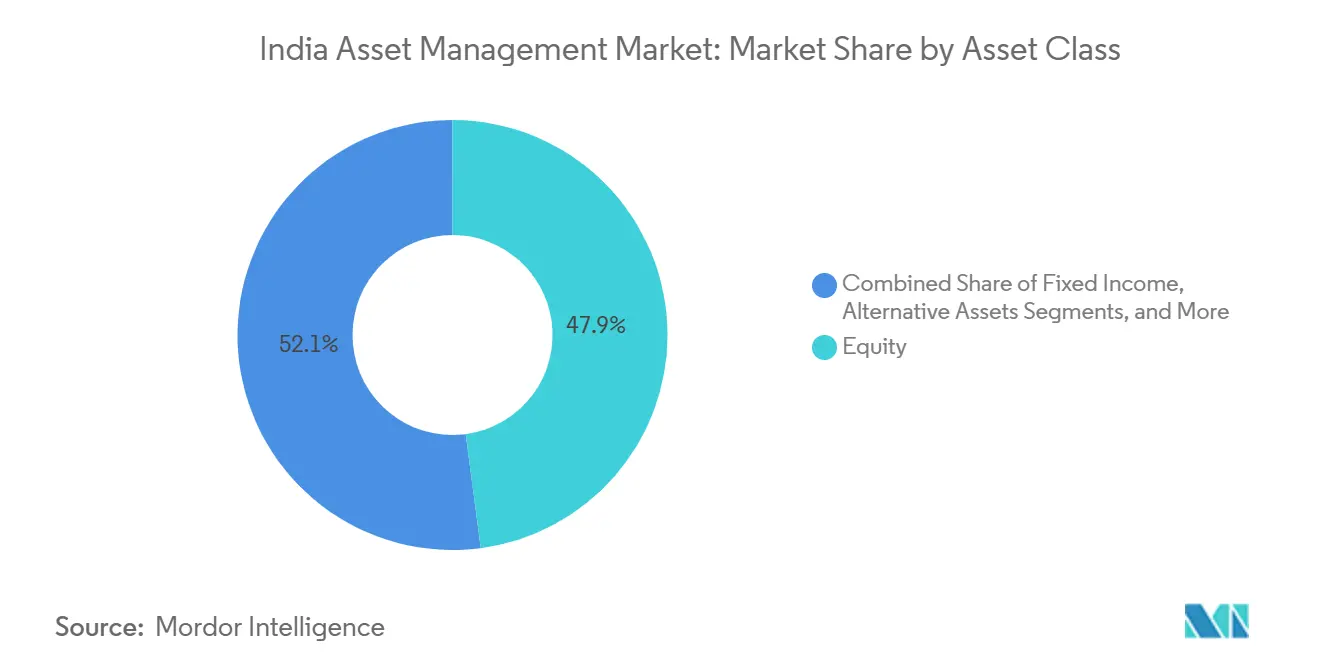India Asset Management Market Analysis by Mordor Intelligence
The India asset management market's current assets under management stand at USD 2.20 trillion in 2025 and are projected to reach USD 4.52 trillion by 2030, reflecting a robust 15.47% CAGR. The India asset management market is benefiting from the spread of systematic investment plans, pension reform–driven institutional inflows, and digital‐first distribution that reaches investors beyond the top metropolitan cities. Regulatory clarity from SEBI and the International Financial Services Centres Authority (IFSCA) is drawing both domestic and cross-border managers, while tokenisation pilots in GIFT City signal the next wave of product innovation. Fee compression is pushing firms toward scale, alternatives, and data-driven advice, yet rising household financial assets and the tax regime shift continue to enlarge the retail wallet. Portfolio diversification by corporate treasuries and insurance companies offers another durable growth vector for the India asset management market.
Key Report Takeaways
- By asset class, equity held 47.9% of the India asset management market share in 2024, whereas alternatives are forecasted to grow at a 16.85% CAGR to 2030.
- By firm type, banks led with 56.5% of the India asset management market size in 2024, but wealth advisory firms are expected to post the fastest projected growth at 17.27% to 2030.
- By mode of advisory, human advisers served 92.6% of assets in 2024 for the India asset management market; robo-advisory is projected to advance at a 22.43% CAGR through 2030.
- By client type, retail investors contributed 56.6% of 2024 assets, while the institutional segment is expected to expand at a 16.19% CAGR.
- By management source, onshore vehicles commanded 87.2% of the India asset management market size in 2024; offshore-delegated assets are projected to rise at 18.56% CAGR.
- SBI Mutual Fund, ICICI Prudential AMC, HDFC AMC, Nippon India AMC, and Axis AMC together captured a significant share of new folio additions in FY25, underscoring a highly scale-driven top tier.
India Asset Management Market Trends and Insights
Drivers Impact Analysis
| Driver | (~) % Impact on CAGR Forecast | Geographic Relevance | Impact Timeline |
|---|---|---|---|
| Retail SIP boom & digital on-boarding | +4.2% | National; rapid uptake in tier-2 and tier-3 cities | Medium term (2-4 years) |
| Surge in alternatives (AIF & PMS) | +3.1% | Urban hubs and GIFT City | Long term (≥ 4 years) |
| Pension reforms driving NPS inflows | +2.8% | Nationwide; corporate concentration | Long term (≥ 4 years) |
| GIFT City cross-border fund passporting | +1.9% | GIFT City with spill-over to Mumbai | Medium term (2-4 years) |
| Tokenised funds & DLT-enabled operations | +1.4% | Initially GIFT City | Long term (≥ 4 years) |
| SEBI risk-based supervision | +1.1% | National regulatory framework | Short term (≤ 2 years) |
| Source: Mordor Intelligence | |||
Retail SIP boom & digital on-boarding
Monthly SIP contributions climbed significantly to INR 26,632 crore by December 2024, giving asset managers a predictable cash pipeline that cushions foreign outflows. Smartphone penetration and Aadhaar-based e-KYC have shrunk account-opening time from weeks to minutes, enabling first-time buyers across smaller cities. SIP assets now represent a considerable share of industry AUM, highlighting structural stickiness that anchors the India asset management market during volatile cycles. Rising disposable income and the simplified personal-income tax regime support projections of INR 40,000 crore in monthly inflows within two years. AMFI investor awareness campaigns reinforce this momentum[1]Association of Mutual Funds in India, “Monthly Industry Data, December 2024,” amfiindia.com.
Surge in alternatives (AIF & PMS)
Total AIF commitments have grown significantly in recent years, driven by Category II private equity and private credit strategies that offer stronger risk-adjusted returns compared to public markets. Category III funds, although smaller, demonstrate superior capital churn, while Category I infrastructure vehicles align with national capex priorities. Average AIF holding periods of six-plus years elevate liquidity risk, yet high-net-worth investors accept these constraints for potential alpha. Regulatory sandboxes in GIFT City lower setup frictions, positioning the India asset management market for deeper alternative penetration.
Pension reforms driving NPS inflows
NPS assets reached INR 14.43 lakh crore in 2025 after the Budget raised the employer contribution cap to 14% of salary, enhancing corporate adoption. Corporate subscriber numbers grew as well, and the new NPS Vatsalya scheme widens coverage to minors, embedding retirement investing early. Flexible equity caps have demonstrated significant one-year returns, validating a market-linked pension model. Although penetration remains low among the population, the larger payroll base positions pensions as a long-term catalyst for the India asset management market[2]Pension Fund Regulatory and Development Authority, “NPS Statistics 2025,” pfrda.org.in.
GIFT City cross-border fund passporting
IFSCA recently achieved a significant milestone in AIF approvals, substantially increasing aggregate commitments while reducing the minimum corpus threshold. Special Purpose Vehicle structures enable leverage and co-investment, enhancing India’s competitiveness against other prominent financial hubs. Outbound allocations have grown as wealthy Indians diversify overseas within a tax-neutral wrapper. Negotiations for bilateral fund passporting promise wider market access, though hedging costs and FX regulations still deter smaller firms[3]International Financial Services Centres Authority, “List of Registered Fund Management Entities — April 2025,” ifsca.gov.in.
Restraints Impact Analysis
| Restraint | (~) % Impact on CAGR Forecast | Geographic Relevance | Impact Timeline |
|---|---|---|---|
| Fee compression from passives | -2.1% | National; stronger in metros | Medium term (2-4 years) |
| Volatility & rich equity valuations | -1.8% | Nationwide equity markets | Short term (≤ 2 years) |
| Analytics/AI talent shortage | -1.2% | Mumbai, Bengaluru, Hyderabad | Medium term (2-4 years) |
| Liquidity mismatch in privately placed alts | -0.9% | Alternative asset hubs | Long term (≥ 4 years) |
| Source: Mordor Intelligence | |||
Fee compression from passives
Low-cost index funds and ETFs captured INR 33,000 crore in Q1 2025 inflows, while active debt funds saw INR 8,000 crore outflows. Expense ratios in broad-market equity index funds have fallen below 10 basis points, intensifying pressure on active managers to produce persistent alpha. Global precedents of 60% fee declines over two decades serve as a cautionary benchmark. As passives reach 17% of AUM, managers must pivot toward factor, thematic, or private-market niches to defend margins within the India asset management market.
Volatility & rich equity valuations
Elevated P/E multiples in large-cap technology and healthcare have trimmed future return expectations. SEBI stress testing for mid- and small-cap funds underscores regulators’ vigilance. Foreign portfolio investors paused buying in late 2024, exposing vulnerability when domestic flows waver. Yet disciplined asset re-allocation toward energy and consumer discretionary sectors has partly cushioned drawdowns, showcasing market depth that reinforces long-term domestic confidence.
Segment Analysis
By Asset Class: Alternatives Gain Speed alongside Equity Core
Equity retained a sizeable 47.9% slice of the India asset management market in 2024, energised by the SIP engine and long-horizon retail savings. Despite this dominance, alternatives are sprinting ahead with a 16.85% CAGR, signalling an appetite for differentiated risk-return profiles. Family offices and corporate treasuries are lifting allocations to private equity, private credit, and real-estate investment trusts, chasing low-correlation yields. Fixed income allocations are underweight due to rate-cycle uncertainty, while gold and commodity funds enjoy tactical inflows as inflation hedges. Tokenisation pilots may soon allow fractionalisation of alternative pools, lowering ticket sizes for accredited investors and adding depth to the India asset management market.
The bifurcation widens: retail investors stick with low-cost diversified equity funds using SIPs, whereas wealthy cohorts leverage bespoke AIF structures. Regulatory guardrails limiting leverage and mandating portfolio transparency in Category III funds promote risk management without stifling innovation. As infrastructure remains a national priority, Category I AIFs bridge public spending gaps, establishing a policy-capital feedback loop. Collectively, alternatives are forecast to form 15% of the India asset management market size for this asset class by 2030, compressing the equity share by a modest two percentage points while broadening overall product choice.
Note: Segment shares of all individual segments available upon report purchase
By Firm Type: Advisors and Digital Brokers Nibble at Bank Strongholds
Banks owned 56.5% of the India asset management market size in 2024 on the back of branch distribution and bundled retail relationships. Yet registered investment advisers and specialised wealth firms are expanding at 17.27% CAGR, harnessing transparent fee-only models and tailored asset allocation. Banks’ universal-banking advantage meets competition from discount brokers that convert trading clients into long-term fund investors via goal-based nudges. Meanwhile, family offices outsource product due diligence to boutique advisory shops that promise open-architecture selection. Consolidation has begun: HSBC’s acquisition of L&T Mutual Fund reflects global entrants seeking instant scale. Six fresh licence approvals for 2025—including Jio BlackRock and Angel One—will drag pricing lower, even as technology investment rises. Diversification across advice channels ensures the India asset management market remains contestable rather than monopolistic.
Digital advice platforms push hyper-personalised nudges through data analytics, eroding cross-sell inertia enjoyed by incumbents. Banks respond with robotic process automation in back-office functions and partnership models that integrate fintech interfaces while retaining custody. Broker-dealers hover in the middle, converting order-flow income into advisory subscriptions. Over the next five years, the top 10 firms may still hold half of the assets, but the long tail of niche firms and digital pure-plays will collectively enlarge the pie rather than simply cannibalise bank share.
By Mode of Advisory: The Hybrid Model Finds Its Footing
Human advisers still account for 92.6% of AUM of the India asset management market in 2024, a testament to cultural preference for relational trust and the perceived complexity of multi-goal financial planning. However, robo advisers are compounding at 22.43% annually, mainly across metro millennials. The hybrid model—algorithmic proposals overseen by a licensed planner—offers balanced cost and reassurance. Within the India asset management industry, 39 fintechs already bundle automated rebalancing with optional video consultations, blurring boundaries between pure robo and traditional models.
SEBI’s nascent guidelines on algorithmic advice will decide scaling speed; early adoption grants first-mover credibility but also heavier compliance obligations. For now, the India asset management market is likely to see robo models capturing commodity allocation tasks, leaving high-touch life-stage planning to humans.
By Client Type: Retail Bedrock Meets Institutional Momentum
Retail investors contributed 56.6% of flows in 2024, underlining the democratic, broad base of the India asset management market. Over 5.13 crore new investors opened folios in 2024 alone, propelled by e-KYC and the ubiquity of UPI payments. Women now form 26% of the investor cohort, expanding much faster than the overall base. Institutional mandates, however, are rising at a 16.19% CAGR, fuelled by pension funds, insurers, and state-run entities reallocating to public equities and alternatives. EPFO channelled INR 53,081 crore into ETFs in FY25, while insurers diversified surplus into longer-duration bond funds.
Corporates chasing yield on idle cash drive demand for ultra-short-duration and overnight funds, enhancing liquidity for asset managers. Treasury departments also experiment with passively managed equity funds to sidestep active-manager risk. The India asset management market share for institutions is projected to rise considerably by 2030, creating a more balanced flow mix that stabilises redemption cycles and provides longer-tenor capital for complex strategies.
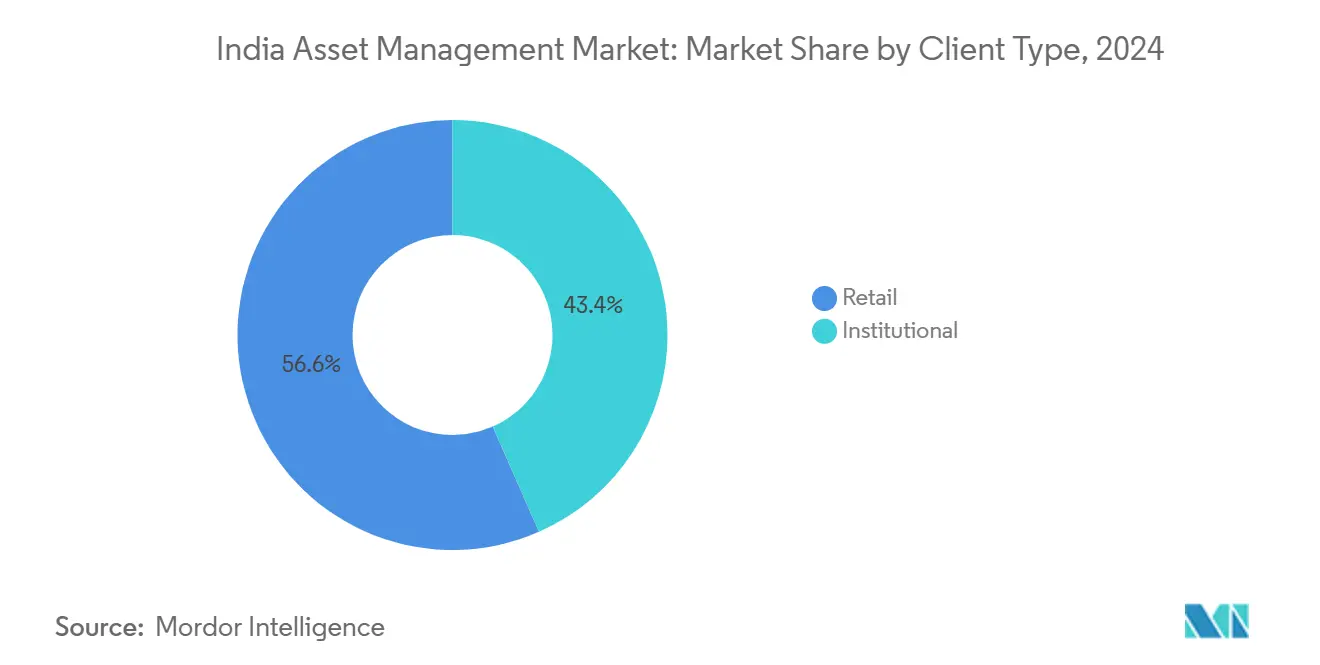
Note: Segment shares of all individual segments available upon report purchase
By Management Source: Onshore Core with an Offshore Halo
Onshore vehicles represented 87.2% of assets in 2024, reflecting favourable tax treatment and deep local knowledge. Nevertheless, offshore-delegated pools governed from GIFT City are compounding at 18.56% CAGR. Currency hedging remains an expense hurdle but is offset by 10-year tax holidays and simplified company law. Reciprocal passporting arrangements under discussion with Mauritius and the UAE could shorten time-to-market for structures serving non-resident Indians and foreign institutions.
Domestic majors set up parallel IFSC units to manage overseas feeder assets while retaining India mandates onshore. Boutique managers exploit GIFT City's flexibility to build thematic global funds that would face capital-control restrictions onshore. The dual-jurisdiction model thus adds optionality rather than shifting the centre of gravity.
Geography Analysis
Mumbai anchors the India asset management market with the densest cluster of asset managers, custodians, and index providers. The city hosts the bulk of decision-makers for institutional mandates and maintains immediate proximity to regulators such as SEBI and the Reserve Bank of India, making it the preferred domicile for flagship funds and discretionary PMS mandates. Delhi-NCR and Bengaluru trail close behind: Delhi for its corporate treasuries and policy advocacy, Bengaluru for its blend of technology talent and rapidly expanding affluent workforce. These hubs collectively process the lion’s share of digital flow, and their infrastructure—co-location facilities, fund-accounting firms, and fintech incubators—creates positive network effects that deepen market liquidity.
Beyond metros, tier-2 and tier-3 cities such as Indore, Coimbatore, and Lucknow now punch above their weight. High-speed mobile data coverage and ubiquitous UPI payments allow distributors to run low-capex advisory models, lowering customer-acquisition costs. SIP inflows from non-metro regions grew faster than metro inflows for a third consecutive year, validating the retail-inclusion strategy that underlies stable expansion of the India asset management market. Financial-literacy programmes run by AMFI and NSE have embedded basic risk awareness, which, when combined with simplified vernacular KYC interfaces, accelerates first-time participation.
GIFT City in Gujarat acts as a geographic outlier: a fully offshore enclave inside the domestic border. Zero capital-gains tax on foreign currencies and single-window clearance attract international asset managers who previously operated from Singapore. The proximity of back-office hubs in Ahmedabad lowers wage costs relative to Mumbai, while direct flight links to Dubai and Singapore simplify executive travel. As the only jurisdiction in India legally hosting dollar funds, GIFT City positions the country to intermediate South-South capital flows, reinforcing India’s aspiration to become a regional wealth-management hub interconnected with both Asia and the Middle East.
Competitive Landscape
Scale leaders anchor competition: SBI Mutual Fund achieved significant growth in 2025, leveraging a 22,000-branch banking network and government payroll trust. ICICI Prudential and HDFC AMC are investing heavily in AI-assisted customer profiling that cuts acquisition costs in semi-urban markets. Collectively, the top five captured a significant share of new folios in FY25, underscoring significant but not overwhelming concentration in the India asset management market. Technology is the new battleground: incumbents migrate legacy mainframes to cloud-native stacks to shrink statement-generation time and enable same-day settlement testing.
Entry barriers fall as Jio BlackRock combines 5G reach with deep content marketing to access first-time investors, while Angel One plans an ETF-heavy lineup that rides its discount-broker brand equity. These entrants intensify fee competition, prompting incumbents to expand into alternatives where performance fees insulate margins. Cross-border ambitions also intensify: Kotak and Aditya Birla Sun Life anchor offshore feeder structures in GIFT City to court foreign pension funds wanting India exposure without rupee-conversion risk. Domestic managers without offshore arms risk losing mandates to global houses that can bundle India with diversified Asia portfolios.
ESG integration, once a marketing veneer, has shifted to a regulatory imperative as SEBI formalised BRSR (Business Responsibility and Sustainability Reporting) for listed companies. Managers scramble for proprietary ESG scoring models while engaging proxy advisory specialists. Cybersecurity upgrades mandated by SEBI’s 2024 circular now consume a growing slice of IT budgets, favouring firms able to amortise fixes across scale. Smaller boutiques may collaborate via shared regtech platforms to stay compliant. Thus, while the India asset management market remains growth-oriented, operational excellence and technology adoption increasingly differentiate winners from strugglers.
India Asset Management Industry Leaders
-
SBI Mutual Fund
-
ICICI Prudential AMC
-
HDFC AMC
-
Nippon India AMC
-
Axis AMC
- *Disclaimer: Major Players sorted in no particular order
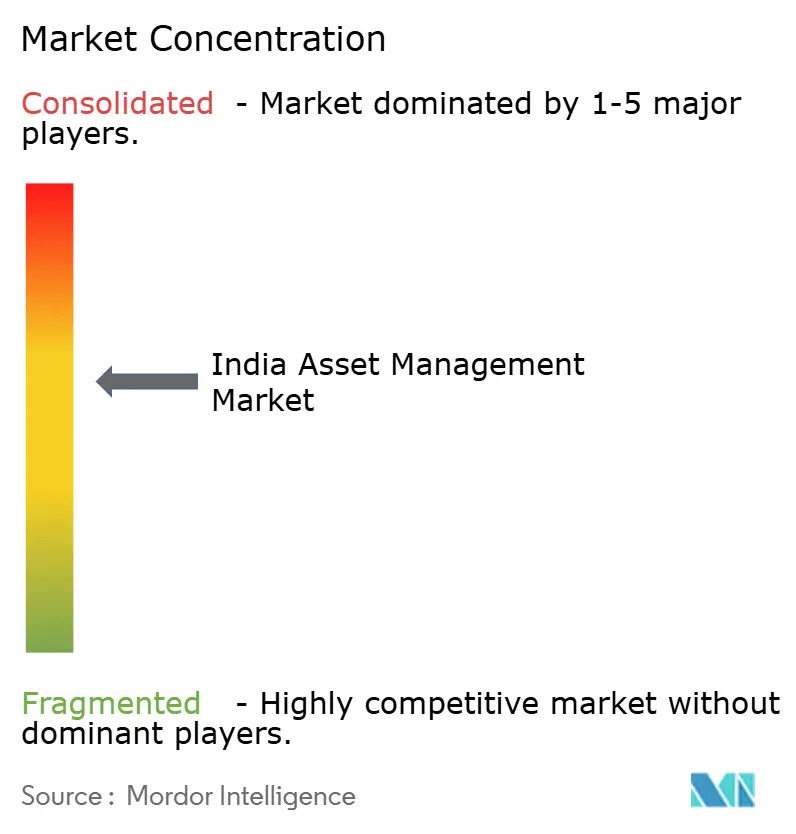
Recent Industry Developments
- May 2025: Kotak Mahindra AMC achieved first close of its Kotak Credit Opportunities Fund at INR 1,200 crore, signaling continued appetite for private-credit strategies.
- April 2025: SEBI launched a beta T+0 settlement cycle for equity trades, aiming to improve market liquidity and operational efficiency.
- February 2025: IFSCA issued a consultation paper on the tokenization of real-world assets to enable blockchain-native fund structures, inviting stakeholder comments by April 30, 2025.
- January 2025: SEBI approved six new mutual fund houses, including Jio BlackRock and Angel One, expanding investor choice and stimulating price competition.
India Asset Management Market Report Scope
Asset management is a systematic approach to the governance and realization of value from the things a group or entity is responsible for over its life cycle. It may apply both to tangible assets (physical objects such as buildings or equipment) and intangible assets (such as human capital, intellectual property, goodwill, or financial assets). The India Asset Management Market is segmented by Client Type (Retail, Pension Funds, Insurance Companies, Banks, and Others) and by Asset Class (Equity, Fixed Income, Cash/Money Management, Alternative Investment, and Others). The report offers market size and forecasts in value (USD billion) for all the above segments.
| By Asset Class | Equity |
| Fixed Income | |
| Alternative Assets | |
| Other Asset Classes | |
| By Firm Type | Broker-Dealers |
| Banks | |
| Wealth Advisory Firms | |
| Other Firm Types | |
| By Mode of Advisory | Human Advisory |
| Robo-Advisory | |
| By Client Type | Retail |
| Institutional | |
| By Management Source | Offshore |
| Onshore |
| Equity |
| Fixed Income |
| Alternative Assets |
| Other Asset Classes |
| Broker-Dealers |
| Banks |
| Wealth Advisory Firms |
| Other Firm Types |
| Human Advisory |
| Robo-Advisory |
| Retail |
| Institutional |
| Offshore |
| Onshore |
Key Questions Answered in the Report
What is the current India asset management market size?
The India asset management market size stands at USD 2.20 trillion in 2025 and is forecast to reach USD 4.52 trillion by 2030.
How fast is the India asset management market growing?
The market is projected to expand at a 15.47% CAGR between 2025 and 2030, one of the highest growth rates among major global markets.
Which asset class is growing the fastest in India?
Alternative investment funds, including private equity and private credit, are expected to grow at a 16.85% CAGR through 2030, outpacing other asset classes.
How significant are systematic investment plans (SIPs) to market growth?
SIPs contribute to a considerable share of mutual-fund AUM and generate monthly inflows exceeding INR 26,000 crore, providing a stable retail engine for the industry.
What role does GIFT City play in asset management?
GIFT City hosts India’s International Financial Services Centre, offering dollar-denominated fund structures, tax incentives, and tokenisation pilots that attract both domestic and foreign managers.
Are robo-advisers replacing human advisers in India?
Human advisers still serve more than 90% of assets, but robo and hybrid models are scaling at over 22% annually, mainly among urban, tech-savvy investors.
Page last updated on:
